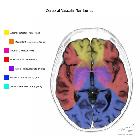recurrent artery of Heubner





Recurrent artery of Heubner, also known as the medial striate artery or long central artery, is the largest perforating branch from the proximal anterior cerebral artery (ACA) and is the only one routinely seen on angiography.
Gross anatomy
Origin and course
Its origin is near the A1-ACOM-A2 junction of the ACA, arising from the proximal A2 in 90% of cases, and from the distal A1 in 10% of cases. Rarely, it can arise from AComA or have a common origin with the frontopolar artery. It then curves back sharply on itself, paralleling the A1 and is at risk from ACOM aneurysm clipping (see case 1).
Supply
The recurrent artery of Heubner has vascular supply mainly to :
- head of the caudate nucleus
- medial portion of globus pallidus
- anterior crus of the internal capsule
- anterior hypothalamus
- nucleus accumbens
- parts of the uncinate fasciculus
- diagonal band of Broca
- basal nucleus of Meynert
Variant anatomy
It may be absent in 3% or duplicated in 12% of individuals. In some patients it may be triplicated or even quadruplicated .
History and etymology
It is named after Johann Otto Leonhard Heubner, a German pediatrician (1843-1926), who first described his eponymous vessel in 1872 .
Related pathology
Clinical manifestations of occlusion:
- unilateral
- weakness contralateral arm
- weakness contralateral face
- dysarthria
- hemichorea
- bilateral
- akinetic mutism
Siehe auch:
- intrakranielle arterielle Gefäßanomalien
- Arteria cerebri media
- Arteria cerebri anterior
- medial lenticulostriate arteries
- Arteria communicans anterior
- akzessorische Arteria cerebri media
und weiter:

 Assoziationen und Differentialdiagnosen zu Heubner-Arterie:
Assoziationen und Differentialdiagnosen zu Heubner-Arterie:




